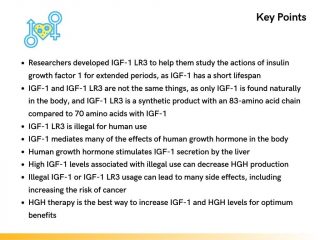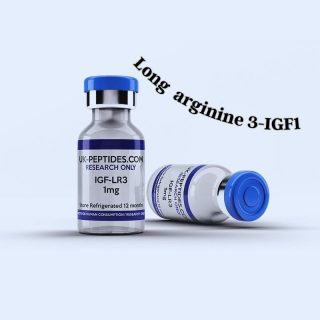Everything You Should Know About IGF-1 LR3 Injections
 IGF-1 LR3 is not the same as insulin growth factor 1 (IGF-1), an essential hormone released from the liver in response to signals from human growth hormone (HGH). Additionally, HGH regulates IGF-1’s paracrine production in other tissues. IGF-1 (also called somatomedin C) mediates the anabolic and mitogenic cellular activities of HGH while having specific effects, including on cartilage cells.
IGF-1 LR3 is not the same as insulin growth factor 1 (IGF-1), an essential hormone released from the liver in response to signals from human growth hormone (HGH). Additionally, HGH regulates IGF-1’s paracrine production in other tissues. IGF-1 (also called somatomedin C) mediates the anabolic and mitogenic cellular activities of HGH while having specific effects, including on cartilage cells.
In children, IGF-1 deficiency can lead to growth abnormalities even when HGH levels are normal. That shows the independent action of IGF-1 in addition to its mediating properties of HGH.
IGF-1 LR3, or long arginine 3-IGF1, is a synthetic protein possessing arginine in place of the glutamic acid part of the amino acid sequence. This comprehensive review looks at the differences between IGF-1 and IGF-1 LR3, including purpose, benefits, side effects, and options for treatment.
What Is IGF-1 LR3 Used For?
Researchers developed IGF-1 LR3 to help them study insulin growth factor 1’s actions for extended periods, as IGF-1 has a short lifespan. Additionally, the binding of IGF-1 to other proteins can alter some test results. 
The sole purpose of IGF-1 LR3 is laboratory analysis. Companies have produced it in oral and intramuscular injection forms, selling it illegally for bodybuilding purposes.
- Is IGF-1 LR3 the same as IGF-1?
IGF-1 and IGF-1 LR3 are not the same. Insulin growth factor 1 is a 70-amino acid chain peptide compared to 83 amino acids in IGF-1 LR3. Here are some key differences between IGF-1 and IGF-1 LR3:
Insulin Growth Factor 1: IGF-1 is a hormone produced by the liver in response to human growth hormone (HGH) signals. IGF-1 mediates specific HGH functions, including cellular growth and regeneration (crucial for muscle and bone formation, organ preservation, skin, hair, and nails), nerve myelination, neural development, glucose uptake by the tissues, amyloid clearance (protection against Alzheimer’s disease), and vasodilation for increased blood flow. Receptors for IGF-1 are found on the surface of most cells in the body.
IGF-1 is also produced outside the liver by peripheral tissues (including bone and skeletal muscle), with autocrine and paracrine functions independent of HGH. Paracrine IGF-1 provides protection for and improves functional recovery of the brain after a stroke.
IGF-1 is closely related to insulin, with both high and low IGF-1 levels contributing to glucose intolerance, insulin resistance, and increased risk of type 2 diabetes. Human growth hormone and IGF-1 interact with insulin in regulating carbohydrate metabolism. IGF-1 enhances insulin sensitivity through its binding to insulin receptors. One problem of increasing IGF-1 levels separately from human growth hormone is that it suppresses HGH production. That action can lead to a negative effect on functions dependent on HGH and IGF-1 signaling.
IGF-1 LR3: Although only legal for laboratory use, this synthetic version of IGF-1 is often used to speed fat breakdown and increase skeletal muscle growth when injected intramuscularly. It has not been evaluated well in humans, and its long-term effects are unknown. Because of its ability to stimulate cell reproduction, it could be a carcinogen, and more testing is necessary. The longer lifespan of IGF-1 LR3 over IGF-1 is beneficial for studying insulin growth factor 1 effects in a laboratory.
- The half-life of IGF-1 LR3
IGF-1 LR3 has not been studied in humans enough to determine with certainty its half-life. It is believed to have a half-life of about 20 to 30 hours (currently unsubstantiated due to lack of research), compared to the half-life of IGF-1 of about 12 to 15 hours. IGF-1 binds to binding proteins (IGF-1BP) to increase its half-life, but that also reduces the affinity to the receptors. Because IGF-1 LR3 binds less to the serum proteins, it has an increased affinity to the IGF-1 receptors. The lack of binding may lead IGF-1 LR3 to be eliminated faster by the body.
- Is IGF-1 LR3 better than HGH?
IGF-1 LR3 is not better than HGH. The HGH/IGF-1 signaling axis requires a balance between these hormones. Administering synthetic IGF-1 in any form ultimately tells the pituitary gland to reduce human growth hormone secretion. High levels of IGF-1 in the bloodstream inhibit growth hormone-releasing hormone (GHRH) secretion from the hypothalamus, decreasing HGH production. Administering IGF-1 LR3 would have the same effect, lowering HGH levels in the body. Because IGF-1 LR3 stays in the body longer, it would have a more detrimental impact on HGH secretion and functions.
Human growth hormone promotes fat breakdown and anabolic effects on muscle tissue that are mediated by IGF-1. HGH also has many other crucial benefits for the adult body, including but not limited to the following:

- Cognitive support
- Emotional well-being
- Sleep quality and duration
- Hormone regulation
- Sexual performance
- Hair and nail growth
- Skin appearance
- Temperature regulation
- Immunity support
Dosage & Administration
The dosage and administration of IGF-1 injections depend on the body’s needs. Hormone replacement requires personalization based on blood test results. IGF-1 LR3 is not intended for human use, so no dosage determination is provided.
IGF-1 LR3 is a freeze-dried (lyophilized) white powder that requires reconstitution with distilled water for research use.
- How much IGF-1 LR3 do you need a day?
We do not recommend any IGF-1 LR3 dosage as it is not licensed for human consumption in any form. There is also no IGF-1 LR3 dosage for fat loss as this product is not regulated as a dietary or weight loss aid.
- Where do you inject IGF-1 LR3?
IGF-1 LR3 should not be injected into the body. The administration is subcutaneous to the abdomen for those prescribed IGF-1 for medical use. Subcutaneous administration of IGF-1 allows for slow release into the body compared to intramuscular injections.
- Does it need to be refrigerated?
IGF-1 requires refrigeration and should not be frozen or left at room temperature.
- When to take IGF-1 LR3?
You should not take IGF-1 LR3 at any time as it is not approved for human use. There is little research available, and there is no way of knowing if it can have long-lasting adverse effects on the body.
Is IGF-1 LR3 FDA-approved?
IGF-1 LR3 is not FDA-approved for human use. Administering IGF-1 LR3 or IGF-1 without proper medical guidance can increase the risk of developing certain types of cancer and decrease human growth hormone production. IGF-1 products are also banned in most sports and are on the World Anti-Doping Agency (WADA) Prohibited List.
What Are the Benefits of IGF-1 LR3?
Due to a lack of research into IGF-1 LR3, we focus on the benefits of IGF-1 for the adult body. As a mediator of HGH, IGF-1 assists with muscle gain, strength, bone reproduction, healing from injuries, and glucose uptake by the cells. IGF-1 acts on insulin receptors to stimulate the body’s cells to take in circulating glucose.
Promoting glucose uptake also helps the body use sugar, so it is not stored as fat. In that way, IGF-1 assists with fat burning. IGF-1 is not a dietary aid and cannot alone stimulate weight loss.
Although often thought of as a way to increase lean muscle, IGF-1 bodybuilding benefits are not stand-alone actions. IGF-1 mediates human growth hormone’s effects on tissue repair and muscular growth.
Side Effects of IGF-1 LR3
Because of its illegal status, IGF-1 side effects are not fully known. People who use this drug illegally do not always report adverse reactions. One potential life-threatening side effect of IGF-1 LR3 is having dangerously low blood sugar (hypoglycemia). For those prescribed IGF-1, the administration is along with a meal to reduce the risk of hypoglycemia.
IGF-1 LR3 before and after side effects may mimic those of IGF-1 use, including edema, seizures, jaw pain, increased kidney and liver mass, myalgia, headaches, and altered liver function. Swelling and redness at the injection site are possible. Some reports have shown that IGF-1 LR3 can influence intestinal mucosa growth, cancer cell growth, and organ enlargement.
IGF-1 LR3 vs. HGH Injections
Before you buy IGF-1 or IGF-1 LR3 illegally, it is crucial to understand the implications of these drugs and their comparison to HGH injections. IGF-1 LR3 has not been studied enough in humans as it is a banned product by the FDA. Human growth hormone has been around for many years and is safe when used under doctor monitoring to treat HGH deficiency.
Because increasing HGH levels in the body will naturally boost IGF-1 secretion by the liver, it is a much better option than administering IGF-1, which can inhibit HGH release. Remember, high IGF-1 levels signal the hypothalamus that the body does not require more human growth hormone. As a primary mediator of HGH actions, IGF-1 requires ample HGH to perform its functions.
We do not provide IGF-1 reviews as it is not a highly recommended treatment. If a person has an IGF-1 deficiency, the cause is often due to low HGH levels. In that case, treating human growth hormone deficiency typically boosts IGF-1 levels.
Final Thoughts
HGH therapy is the best way to boost IGF-1 levels in adults with growth hormone deficiency. Our hormone therapy clinic checks blood hormones and other levels to determine the appropriate treatment for each man and woman.
Our doctors personalize all hormone replacement therapy to ensure our clients achieve superior results without adverse reactions and side effects.

